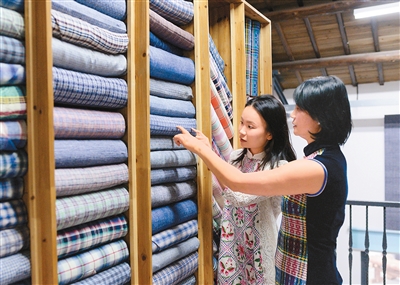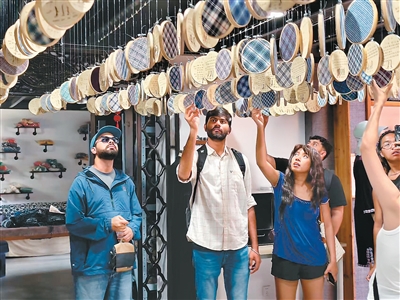




- BRNN
- BRI News
- BRNN News
- Database
Official Documents Polices and Regulations
Inter-government Documents International Cooperation BRI Countries
Business Guide Economic Data BRI Data
Trade
Investment Projects Latest projects
Cases - Content Pool

Zhou Yuxin, left, and her mother inspect Chongming homespun. (Photo courtesy of the interviewee)
In Shanghai's Chongming district, an ancient fabric known as tubu, or Chongming homespun, has been crafted for more than 600 years. As industrialization accelerated, the fabric gradually faded from public view; yet, for many locals, it remains deeply woven into their memories.
Born in 1998, Zhou Yuxin earned her degree in hospitality management from Michigan State University. Today, she has devoted herself to preserving and reimagining this intangible cultural heritage craft. Her career shift reflects not just a personal choice but a broader trend among young people who are rediscovering the value of traditional culture.
Creating a single bolt of Chongming homespun requires dozens of intricate steps. Zhou Yuxin's mother, Zhou Qin, heads an intangible cultural heritage studio dedicated to the craft. Since 1996, she has committed herself to collecting and documenting Chongming homespun. Over nearly three decades, her collection has grown from just 16 bolts to more than 10,000, weighing a total of 30 tonnes.
That dedication left a deep impression on Zhou Yuxin. After returning to Shanghai in 2020 following her studies abroad, she joined a foreign enterprise. But when the global pandemic struck, her mother's export factory faced unprecedented challenges and was eventually forced to close.
"My mother asked me, 'Should we turn the factory space into an exhibition hall? Would you be willing to take it over?'" Zhou recalled.
She agreed without hesitation. Soon after, she began learning dyeing and weaving techniques from teachers at Tsinghua University's Academy of Arts and Design, as well as from Shi Lanjuan, an inheritor of Chongming's tubu weaving craft.

Foreign tourists visit an intangible cultural heritage studio dedicated to Chongming homespun. (Photo courtesy of the interviewee)
Under Shi's guidance, Zhou mastered the complete traditional handweaving process. Yet she refused to be confined by convention, striving instead to fuse heritage techniques with modern innovation.
"Traditional slant looms are extremely heavy. After weaving for hours, your hands tremble. Since modern looms exist, why not use them?" she said. To her, the essence of cultural heritage lies in the spirit of the craft, not in rigidly preserving every original form.
In addition, Zhou has developed a tiered teaching system, offering both intensive courses that cover the full process from cotton cultivation to weaving, and experiential classes where participants can freely create on modern looms.
"Greater accessibility attracts more young people to engage with and appreciate the craft," she explained.
This flexible approach has expanded the audience for Chongming homespun, allowing more people to encounter and understand the fabric in ways that resonate with their own interests.
She also experiments with blending new materials — such as bamboo fiber and paper fiber — with traditional cotton threads, enhancing the fabric's functionality and appeal to modern consumers. She believes that for traditional crafts to succeed today, products must strike a balance between practicality and aesthetic value.
The former factory, once run by her mother, has been converted into a cultural space that integrates exhibitions, hands-on activities and retail. Building on this foundation, Zhou has also ventured into the guesthouse and hotel business.
Those staying at her guesthouse receive complimentary guided tours of the homespun exhibition hall, complete with in-depth storytelling and historical context. The experience extends to their rooms, where handwoven fabrics appear as decorative and functional touches on bedding, tissue box covers, and other details.
The exhibition hall updates its displays and creative cultural products every quarter, ensuring that repeat visitors always discover something new.
In recent years, the mother and daughter have been working to compile a digital archive of Chongming homespun patterns.
Earlier this year, one of these patterns was selected by a leading children's clothing brand. Following a modern redesign, the brand's garments received a strong market reception, earning a substantial licensing fee.
"This opened up new possibilities," Zhou said. "We can extract many festival-related patterns from Chongming homespun and combine them with gift products."

Tel:86-10-65363107, 86-10-65368220, 86-10-65363106